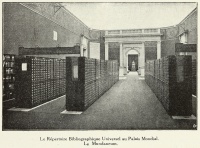Index card
From The Art and Popular Culture Encyclopedia
|
Related e |
|
Featured: |
An index card (or System card in Australian English) is heavy paper stock cut to a standard size. Index cards are often used for recording individual items of information that can then be easily rearranged and filed. It was invented by Carl Linnaeus. The most common size in the United States and Russia is 3 by 5 inches (76 by 127 mm), hence the common name 3-by-5 card. Other sizes widely available include 4 by 6 inches (102 by 152 mm), 5 by 8 inches (127 by 203 mm) and ISO-size A7 (74 mm by 105 mm). Cards are available in blank, ruled and grid styles in a variety of colors. Special divider cards with protruding tabs and a variety of cases and trays to hold the cards are also sold by stationers.
As the name implies, index cards were widely used in the nineteenth and twentieth centuries to create an index to large collections of documents. A major law firm, for example, might have a room full of metal cabinets with drawers designed to hold index cards. Clerks might fill out several cards for an individual document or legal case, allowing them to be filed alphabetically under a number of terms.
See also


